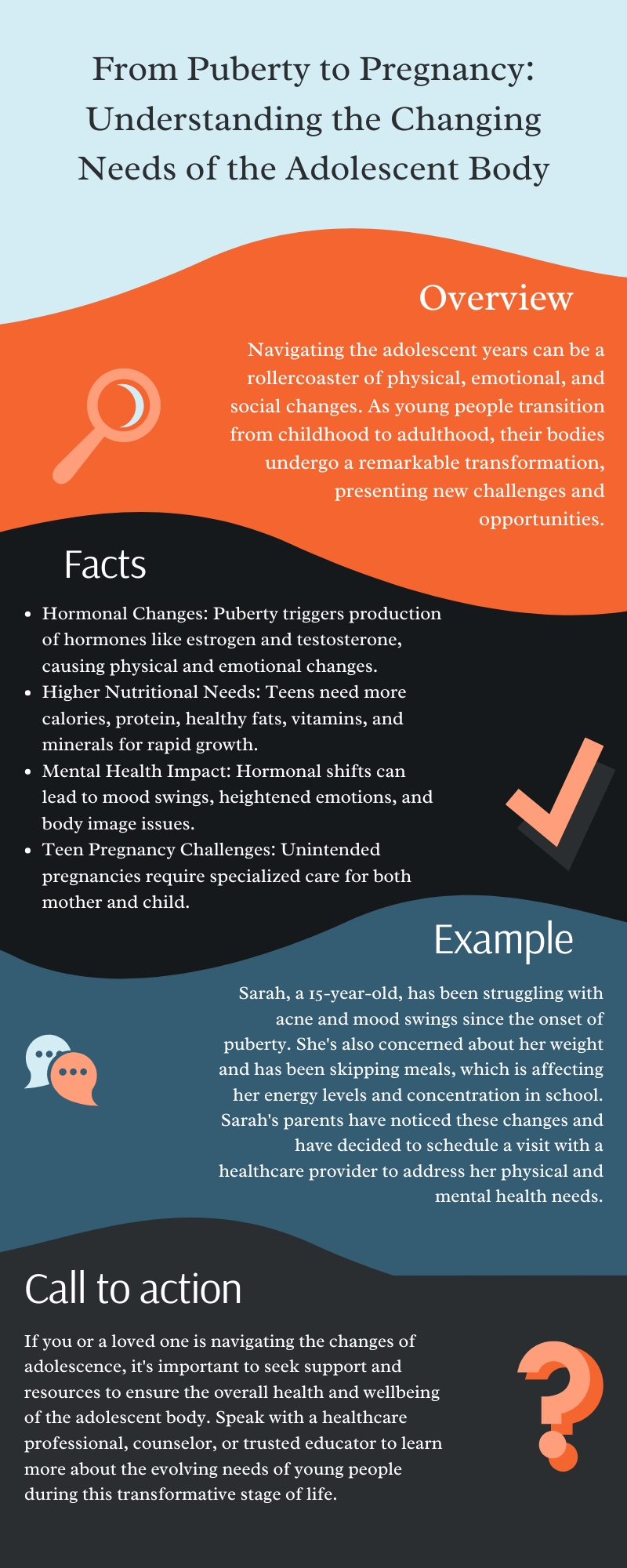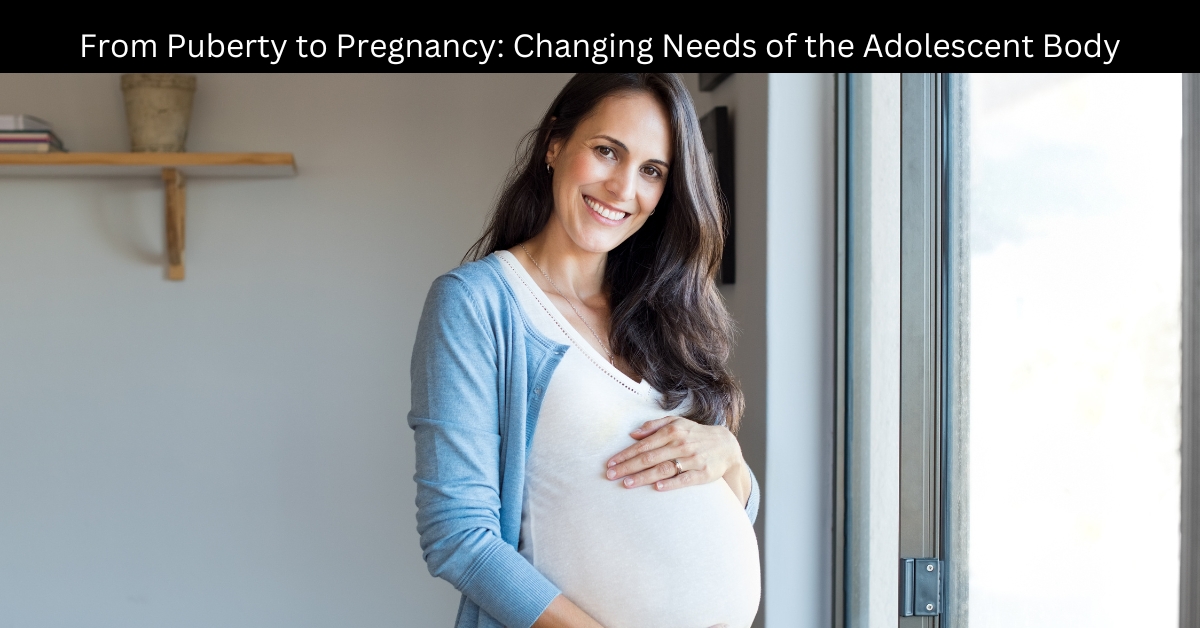Navigating the adolescent years can be a rollercoaster of physical, emotional, and social changes. As young people transition from childhood to adulthood, their bodies undergo a remarkable transformation, presenting new challenges and opportunities.
Understanding the evolving needs of the adolescent body is crucial for ensuring their overall health and wellbeing.
Key Takeaways!
| Key Considerations | Importance |
|---|---|
| Hormonal Changes | Understand the hormonal shifts that drive physical and emotional changes during puberty. |
| Increased Nutritional Needs | Ensure adolescents receive adequate calories, protein, vitamins, and minerals to support rapid growth and development. |
| Mental Health Support | Provide resources and strategies to help adolescents manage emotional challenges and develop a positive body image. |
| Reproductive Health Education | Educate adolescents about menstruation, contraception, and sexually transmitted infections to promote informed decision-making. |
| Pregnancy and Parenting Resources | Offer specialized support and resources for adolescent parents to help them navigate the unique challenges they face. |
The Onset of Puberty
1. Hormonal Changes
- Puberty is a natural process that begins when the body starts producing hormones, such as estrogen and testosterone.
- These hormones trigger the development of secondary sexual characteristics, including breast development, voice changes, and the onset of menstruation in girls.
- The timing and pace of puberty can vary significantly between individuals, with some experiencing it earlier or later than their peers.
2. Physical Changes
- During puberty, the body undergoes a growth spurt, leading to increased height, weight, and the development of muscle mass.
- Adolescents may also experience changes in skin texture, such as the appearance of acne, as well as increased body odor and the growth of body hair.
- These physical changes can be both exhilarating and overwhelming for young people, who may struggle to adapt to their rapidly changing bodies.

Nutritional Needs
1. Increased Caloric and Nutrient Requirements
- Adolescents have higher caloric and nutrient needs compared to children and adults due to the rapid growth and development occurring during this stage of life.
- They require more protein, carbohydrates, healthy fats, vitamins, and minerals to support their physical and cognitive development.
- Ensuring a balanced and nutrient-rich diet is crucial for meeting the increased demands of the adolescent body.
2. Micronutrient Deficiencies
- Adolescents, particularly those with restricted diets or limited access to nutritious foods, may be at risk of developing micronutrient deficiencies, such as iron, calcium, and vitamin D.
- These deficiencies can lead to various health issues, including anemia, bone density problems, and hormonal imbalances.
- Addressing these deficiencies through dietary changes or supplementation is essential for maintaining optimal health during the adolescent years.

Mental Health Considerations
1. Emotional Challenges
- The hormonal and physical changes associated with puberty can also have a significant impact on an adolescent’s mental health.
- Adolescents may experience heightened emotions, mood swings, and increased anxiety or depression, which can affect their overall wellbeing.
- Providing emotional support, counseling, and coping strategies can help young people navigate these challenges.
2. Body Image Concerns
- Adolescents may also struggle with body image issues, as they compare themselves to societal ideals and their peers.
- This can lead to unhealthy behaviors, such as restrictive eating, excessive exercise, or substance abuse, which can further compromise their physical and mental health.
- Promoting a positive body image and self-acceptance is crucial for adolescents during this formative stage of life.

Reproductive Health
1. Menstruation and Contraception
- For adolescent girls, the onset of menstruation can be a significant milestone, bringing with it new responsibilities and considerations.
- Understanding the menstrual cycle, proper hygiene, and contraceptive options is essential for maintaining reproductive health.
- Educating young people about these topics and providing access to resources can help them make informed decisions and avoid unwanted pregnancies.
2. Sexually Transmitted Infections (STIs)
- Sexually active adolescents are at a higher risk of contracting sexually transmitted infections (STIs), which can have long-term health consequences if left untreated.
- Comprehensive sex education, access to testing and treatment, and open communication about safe sexual practices are crucial for protecting adolescent reproductive health.

Pregnancy and Parenting
1. Adolescent Pregnancy
- Unintended pregnancy during the adolescent years can have significant physical, emotional, and social implications for young people.
- Pregnant adolescents require specialized prenatal care, support, and resources to ensure the health and wellbeing of both the mother and the developing child.
2. Parenting Challenges
- Adolescent parents may face unique challenges, such as balancing their own personal and educational goals with the demands of parenthood.
- Providing access to parenting education, childcare resources, and mental health support can help young parents navigate this transition successfully.
Conclusion
Adolescence is a transformative period marked by profound physical, emotional, and social changes. Understanding the evolving needs of the adolescent body is essential for promoting overall health and well-being during this critical stage of life.
By addressing nutritional requirements, mental health considerations, reproductive health, and the unique challenges of pregnancy and parenting, healthcare professionals, educators, and policymakers can help young people navigate the complexities of adolescence and emerge as thriving, confident adults.
FAQs:
- What are the common physical changes during puberty?
Puberty is a significant developmental stage marked by various physical changes, such as growth spurts, the development of secondary sexual characteristics (e.g., breast development, voice changes, and body hair growth), and the onset of menstruation in girls. These changes are driven by the body’s production of hormones like estrogen and testosterone, leading to a remarkable transformation from childhood to adulthood. - How can adolescents meet their increased nutritional needs?
Adolescents have higher caloric and nutrient requirements compared to children and adults due to the rapid growth and development occurring during this stage. They need more protein, carbohydrates, healthy fats, vitamins, and minerals to support their physical and cognitive growth. Ensuring a balanced, nutrient-rich diet is crucial, and addressing any micronutrient deficiencies, such as iron, calcium, or vitamin D, is essential for maintaining optimal health. - What are the common mental health challenges faced by adolescents?
The hormonal and physical changes associated with puberty can significantly impact an adolescent’s mental health. Adolescents may experience heightened emotions, mood swings, anxiety, or depression, which can affect their overall wellbeing. Additionally, body image concerns and the desire to conform to societal ideals can lead to unhealthy behaviors, such as restrictive eating or substance abuse. Providing emotional support, counseling, and coping strategies can help young people navigate these challenges. - How can adolescent parents be supported?
Unintended pregnancy during the adolescent years can have significant physical, emotional, and social implications. Pregnant adolescents require specialized prenatal care, support, and resources to ensure the health and wellbeing of both the mother and the developing child. Adolescent parents may also face unique challenges, such as balancing their own personal and educational goals with the demands of parenthood. Providing access to parenting education, childcare resources, and mental health support can help young parents navigate this transition successfully.



